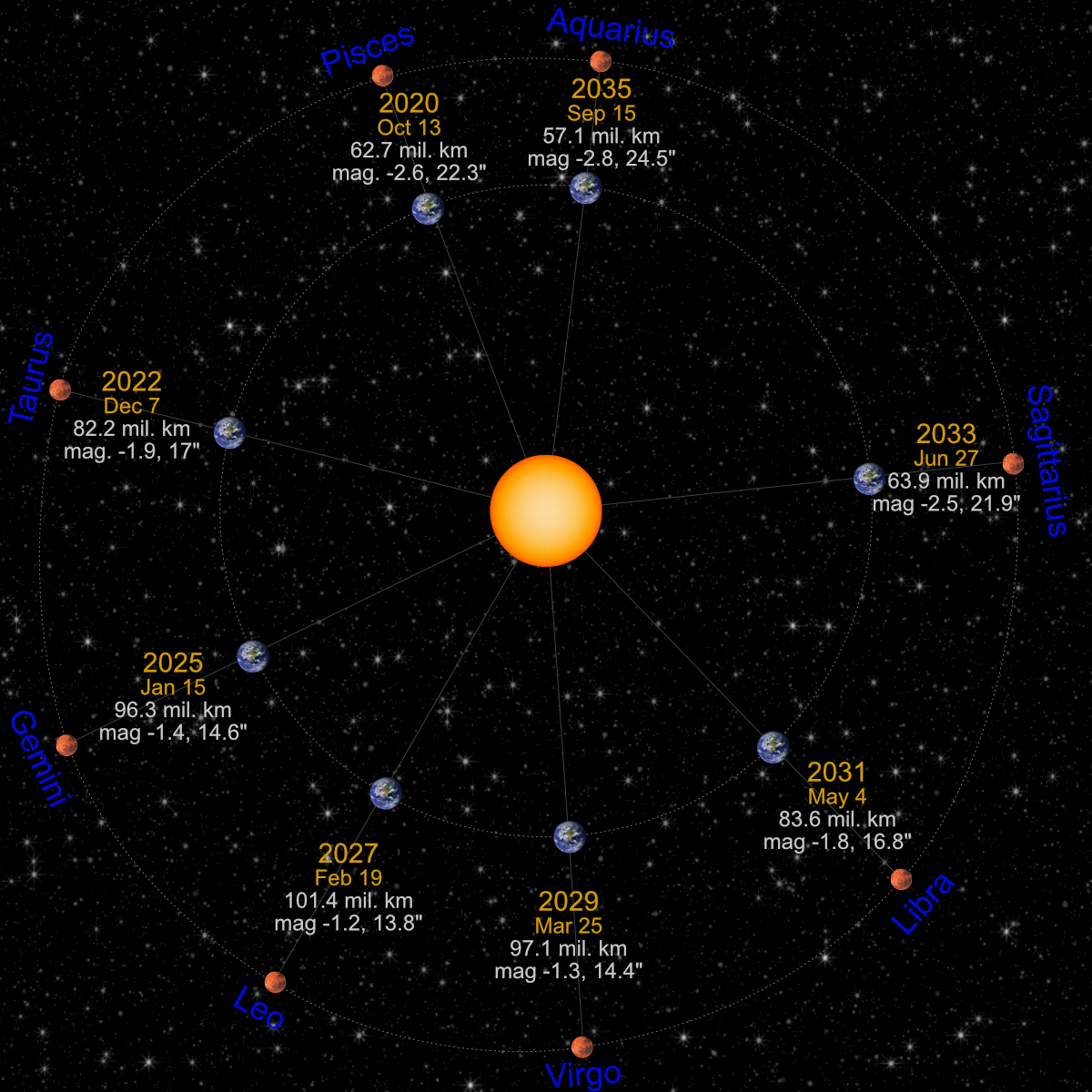| 2022: Mars Opposition Coming (2022-11-18) ⬅︎ |
 |
On December 7, 2022, Earth will catch up to and pass Mars as they both orbit the sun. Since Mars will be
at its
closest, it will appear larger and brighter making this a great time to view its bright red-orange color and to try to
glimpse its polar ice caps and enormous volcanoes through a telescope.
This time is known as opposition because Mars and the sun appear on opposite sides of our sky, 180°
apart. So, when the sun sets in the west, Mars rises in the east and is out all night.
Mars' oppositions occur every 26 months. Jupiter and Saturn oppositions occur every 12-13 months. Why
the difference? It's because Mars is closer to the Earth and is traveling closer in speed to the Earth as they both
orbit the sun. Just like with two runners on a circular track, the more
similar they are in speed, the longer it takes
for the
faster runner to lap the slower one. Earth is faster than Mars but not by a lot. Jupiter and Saturn, being much
further from the Sun than Mars, are far slower
so Earth laps them more
frequently.
Because Mars oppositions occur less frequently than others, stargazers
can get pretty
excited about them. And this one in particular is not to be missed.
The diagram above shows the
oppositions until 2035, with Mar's distance in millions of kilometers, magnitude brightness (lower is brighter), and
size in arc-seconds. Since Mars and Earth orbit the sun in elliptical orbits, rather than perfect circles, the distance
between Mars
and Earth at opposition can vary by a lot. The closer Mars is, the larger and brighter it appears. From the diagram,
you
can see that the opposition in 2022 is special -- Mars will not be closer, brighter or larger until 2033.
A great way to help understand how big and bright Mars is at opposition is to compare it to a full moon. When the
moon is full, its magnitude is about -12. Mars at opposition has magnitude of about -2, ten magnitudes dimmer
-- this is 10,000 times dimmer. (Magnitudes operate on a logarithmic scale, similar to the Richter scale for
measuring earthquakes. For more info, see Measuring Brightness. )
In terms of size in our sky, the moon is about 30' (arc-minutes). This is equal to 0.5° (degrees) and 1800"
(arc-seconds). The size of Mars in our sky at opposition is around 20". This is 90 times smaller in diameter. Even at
opposition, Mars is far
dimmer and smaller than Earth's moon as our photo above shows. Wow! (For more info on angular sizes, see Measuring Distance. )
So why all the excitement? Mars can be a spectacular sight due to is
bright red-orange color and, especially, due to the possibility of
viewing its
surface features -- polar ice caps made of carbon dioxide, enormous volcanoes, canyons and more
-- through a telescope under the best conditions.
Warning: there can be
enormous, unexpected dust storms on the Martian surface that can last for weeks making it nearly
impossible to view other features. The opposition of 2018 occurred during one of these and there were a lot of
disappointed stargazers.
Although an opposition technically occurs at a certain moment in time, the weeks leading up to opposition and the
weeks following are good too. So, if you can, go on out each evening for the weeks before and after to spot this bright
red beauty in the east.
Viewing Mars with a Telescope
No matter the telescope you use, it is critical that the ’seeing’ is
good. This means
the stability of the sky. If you see stars twinkling much, then the seeing is not good and you probably will see only
a red blob. Our
PNW skies often are not stable due to the jet stream overhead.
It is also critical that the 'transparency' is good. Clouds, smoke, and haze can all scatter light and interfere with
viewing. If the
transparency is not good, again, you will probably see only a red blob at best. Our Western Washington skies often
have lots of tiny
droplets of water that can scatter light, especially moonlight.
Then, on a night of good seeing and transparency, it is best to wait until Mars reaches a high altitude — when
it crosses the
meridian due S — because this minimizes the impact of the atmosphere. Our Skymap feature allows you to see
when Mars crosses
the meridian on any day. An hour or so on either side of the crossing should offer the best viewing.
You can find details on viewing the Mars Opposition
here. Be sure to check out our Star Guide feature with its tools for knowing what's out each night and where to
look. Good luck!
|
| |



